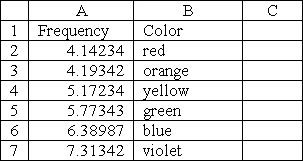
The LOOKUP function has two syntax forms: vector and array.
A vector is a range of only one row or one column. The vector form of LOOKUP looks in a one-row or one-column range (known as a vector) for a value and returns a value from the same position in a second one-row or one-column range. Use this form of the LOOKUP function when you want to specify the range that contains the values you want to match. The other form of LOOKUP automatically looks in the first column or row.
Syntax 1
Vector form
LOOKUP(lookup_value,lookup_vector,result_vector)
Lookup_value is a value that LOOKUP searches for in the first vector. Lookup_value can be a number, text, a logical value, or a name or reference that refers to a value.
Lookup_vector is a range that contains only one row or one column. The values in lookup_vector can be text, numbers, or logical values.
Important The values in lookup_vector must be placed in ascending order: ...,-2, -1, 0, 1, 2, ..., A-Z, FALSE, TRUE; otherwise, LOOKUP may not give the correct value. Uppercase and lowercase text are equivalent.
Result_vector is a range that contains only one row or column. It must be the same size as lookup_vector.
Examples

In the preceding worksheet:
LOOKUP(4.91,A2:A7,B2:B7) equals "orange"
LOOKUP(5.00,A2:A7,B2:B7) equals "orange"
LOOKUP(7.66,A2:A7,B2:B7) equals "violet"
LOOKUP(7.66E-14,A2:A7,B2:B7) equals #N/A, because 7.66E-14 is less than the smallest value in the lookup_vector A2:A7